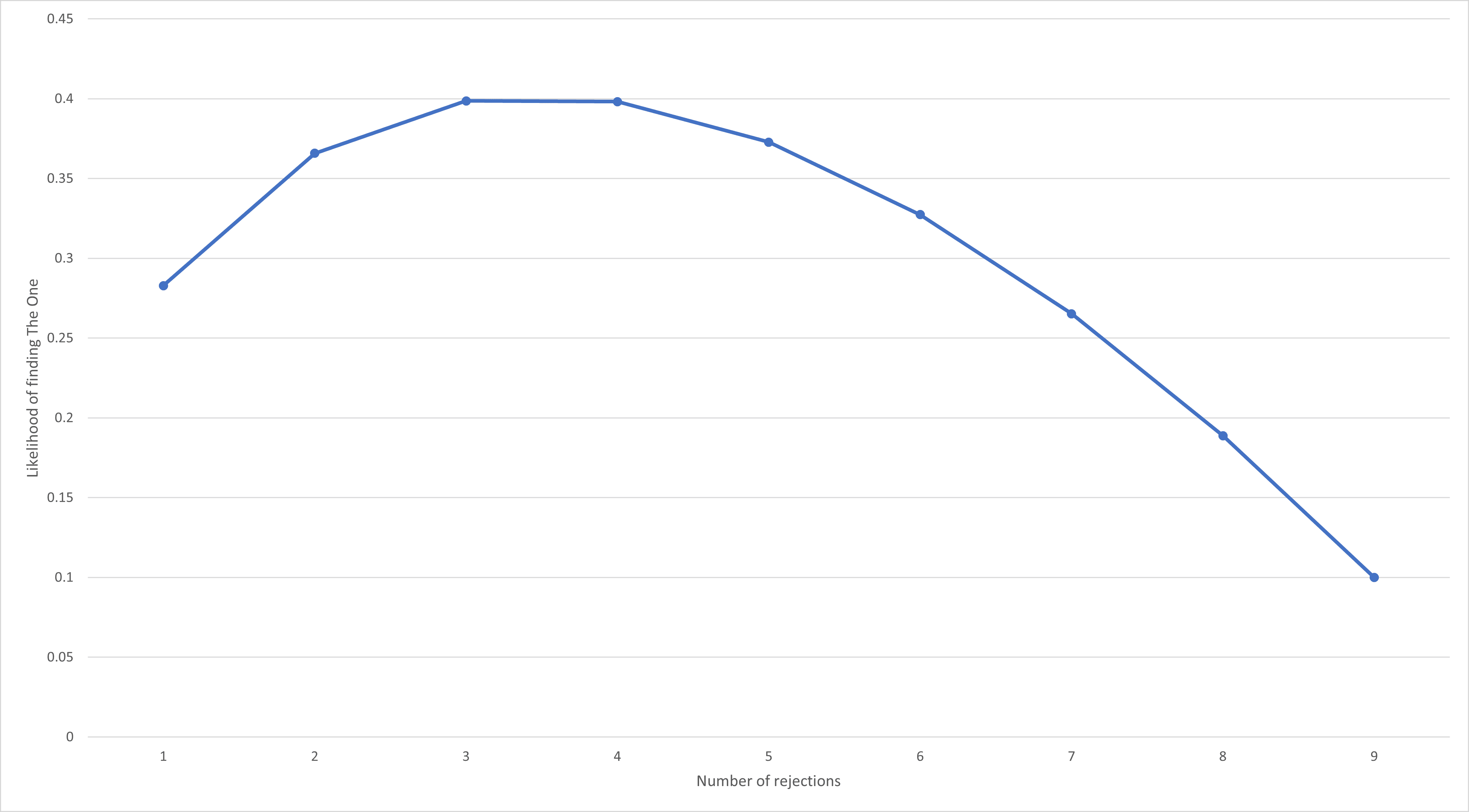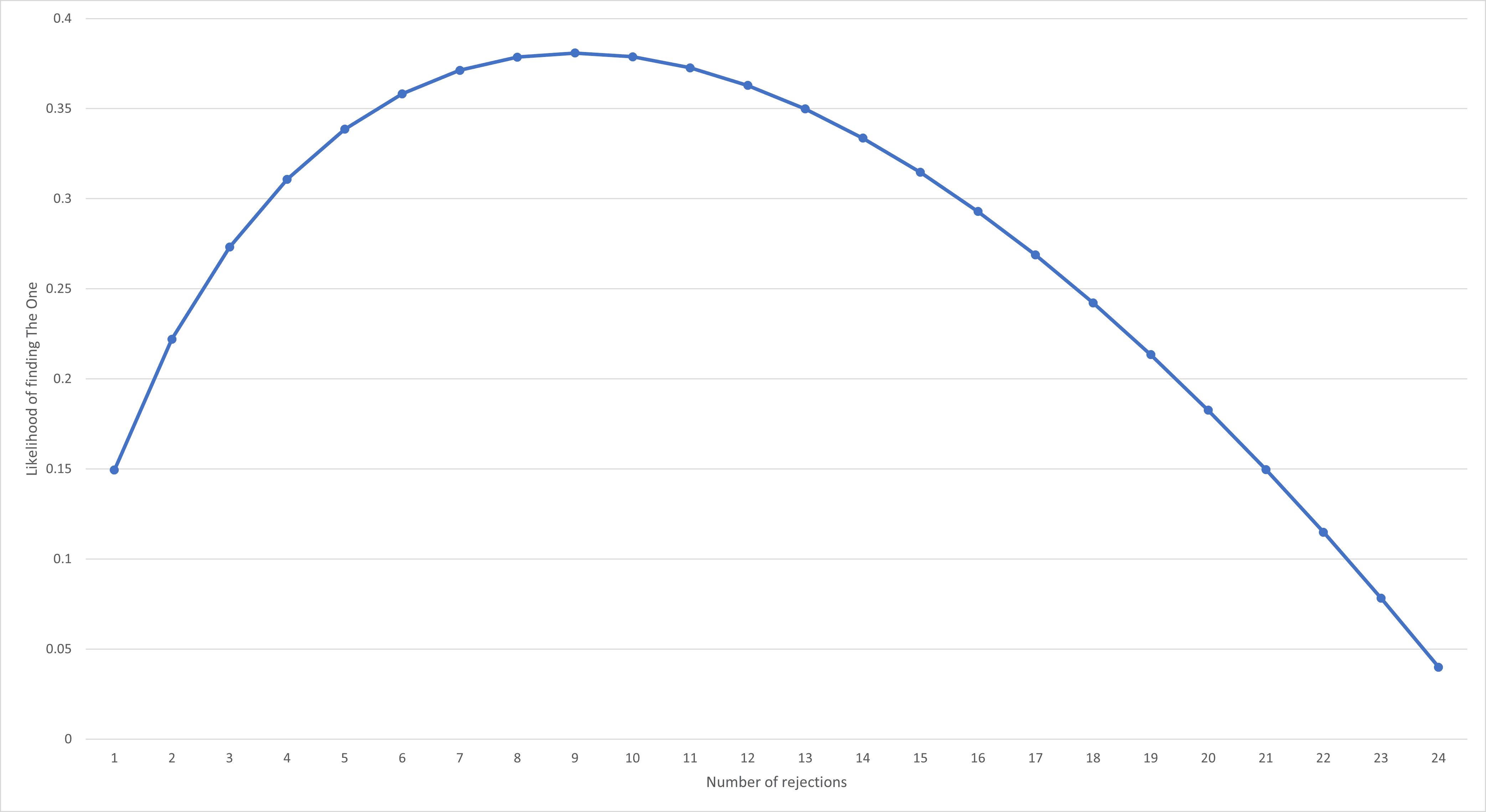“Ay me!” as Lysander once famously said to Hermia. “For aught that I could ever read, Could ever hear by tale or history, The course of true love never did run smooth.” To put it more succinctly: love stinks. But it doesn’t have to! Despite their undeservedly asexual reputation, mathematicians have had a way to find The One for decades – it’s called Optimal Stopping Theory.
“[Optimal stopping theory] literally blows my mind,” wrote mathematician Hannah Fry in her 2015 book The Mathematics of Love: Patterns, Proofs, and the Search for the Ultimate Equation.
“If you chose not to follow this strategy and instead opted to settle down with a partner at random, you’d only have a 1/n chance of finding your true love, or just 5 percent if you are fated to date 20 people in your lifetime, for example,” she explained. “But… following this strategy, you can dramatically change your fortunes, to a whopping 38.42 percent for a destiny with 20 potential lovers.”
So what is this magical formula? Well, it looks like this:

Don’t worry, we’ll explain it in a minute. Image credit: Hannah Fry via Ted.com
But unless you’ve a degree in advanced mathematical matchmaking, that likely doesn’t mean much by itself. Let’s break it down a bit more – and see if we can’t take some dating advice from the equation along the way.
The good news is, it turns out the mathematically-optimal dating game is one you’ve likely been playing already. The best tactic, according to this formula, is to date around for a little while – and once you’ve got a bit of experience of who’s out there, then settle with the first person you meet better than everyone who came before.
And it’s the length of that “little while” that the formula is telling us. So, first of all, we’d better explain the terms. We have P(r) on the left, meaning the probability of finding the best suitor based on r – the number of potential Ones you reject – and n – the total number of possible Mr, Ms, or Mx Rights you have overall.
So, say you’re destined to meet 10 potential romantic partners throughout your lifetime. Then your probability of finding The One depends on how long you hold off like this:

As you get pickier, your chances of finding love increase. Up to a point. Image credit: (C) IFLScience
Following the strategy, your chances top out at just under 40 percent, which you can achieve by rejecting the first four people you date. And sure, a two-in-five chance of finding true love doesn’t sound like a lot, but it’s a lot better than choosing a life partner at random – that would result in just a one in 10 chance that you end up with the right person.
And the more people you’re destined to date, the more optimal stopping theory can improve your odds. For 25 potential partners, your chances look like this:

You can start to see a pattern, no? Image credit: (C) IFLScience
This time, your chances of finding the best match are highest if you reject the first nine potential partners – that gives you a 38.1 percent chance of true love. By comparison, choosing at random would give you just a 4 percent chance.
And if you don’t feel like limiting yourself to a finite number of potential partners – sure, there are only 8 billion people on Earth, but if we need to invade Alpha Centauri to find a date then so be it – then we find the ultimate cut-off: 37 percent.
Now, there are a couple of flaws with this strategy: “Imagine that during your 37-percent-rejection phase you start dating someone who is your perfect partner in every possible way,” Fry points out. “Not yet having met everyone, you’d have no way of knowing that they were the best of your list and you’d let them go.”
“Unfortunately, once you started looking more seriously for a life partner, no one better would ever come along. According to the rules, you should continue to reject everyone else for the rest of your life, grow old and die alone,” she wrote.
And the opposite situation is just as bad: if everyone you reject is terrible and boorish, then “the first person you meet better than everyone who came before” may well be the first person you meet, period. That person might be only the tiniest bit better than previous matches – but nevertheless, the strategy would have you settle down with them into an only-marginally-better-than-awful lifelong partnership.
Then there’s the sheer logistics of it all – after all, who knows in advance how many people they’re going to date in life? But here, at least, the 37-percent rule has an advantage – because as it turns out, it can be used in a whole host of different situations.
So, Fry pointed out, the problem can be adapted to account for time, rather than individuals: “Say you start dating when you are 15 years old and would ideally like to settle down by the time you’re 40,” she explained. “In the first 37 percent of your dating window (until just after your 24th birthday), you should reject everyone… Once the rejection phase has passed, pick the next person who comes along who is better than everyone who you have met before.”
“Following this strategy will definitely give you the best possible chance of finding the number one partner on your imaginary list,” she added.
And it doesn’t even have to apply to romance. “Have three months to find somewhere to live? Reject everything in the first month and then pick the next house that comes along that is your favorite so far,” Fry wrote. “Hiring an assistant? Reject the first 37 percent of candidates and then give the job to the next one who you prefer above all others.”
So there you have it: the key to a successful love life – and possibly also successful house purchasing and hiring strategies – was in math this whole time. This just goes to show what we’ve known all along: math truly is the sexiest of all the sciences. Take that, sexology.
Source Link: How To Use Math To Optimize Your Dating Life